HMG7210 Biostatistics Assignment 2: Analysis of Health Data
VerifiedAdded on 2022/11/25
|10
|1661
|162
Homework Assignment
AI Summary
This biostatistics assignment analyzes data from two studies: one on dyslipidaemia in diabetic patients and another on cardiovascular disease. The assignment explores various variables, including age, BMI, HbA1c levels, and blood pressure, using statistical methods such as bar graphs, T-test...
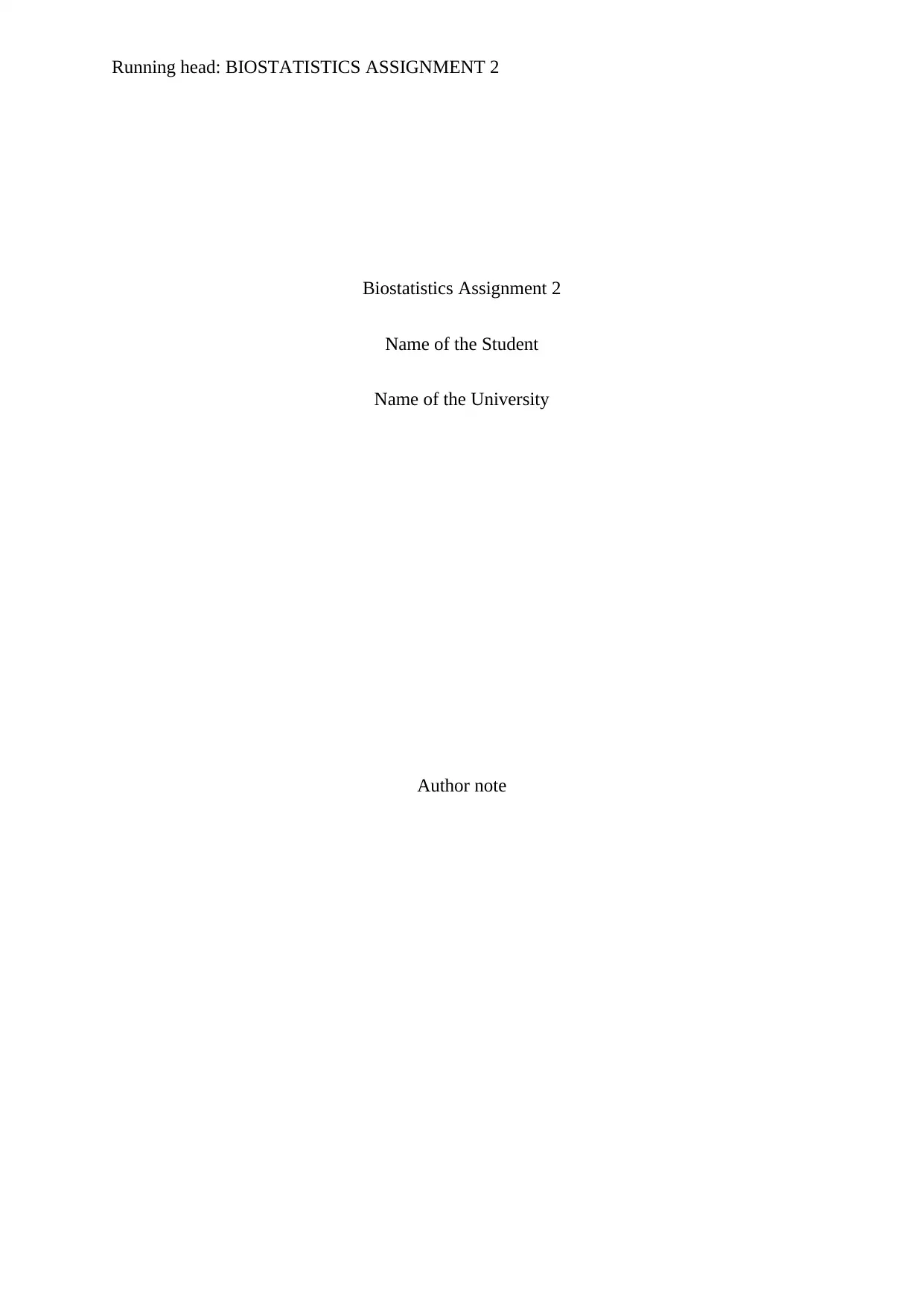
Running head: BIOSTATISTICS ASSIGNMENT 2
Biostatistics Assignment 2
Name of the Student
Name of the University
Author note
Biostatistics Assignment 2
Name of the Student
Name of the University
Author note
Paraphrase This Document
Need a fresh take? Get an instant paraphrase of this document with our AI Paraphraser
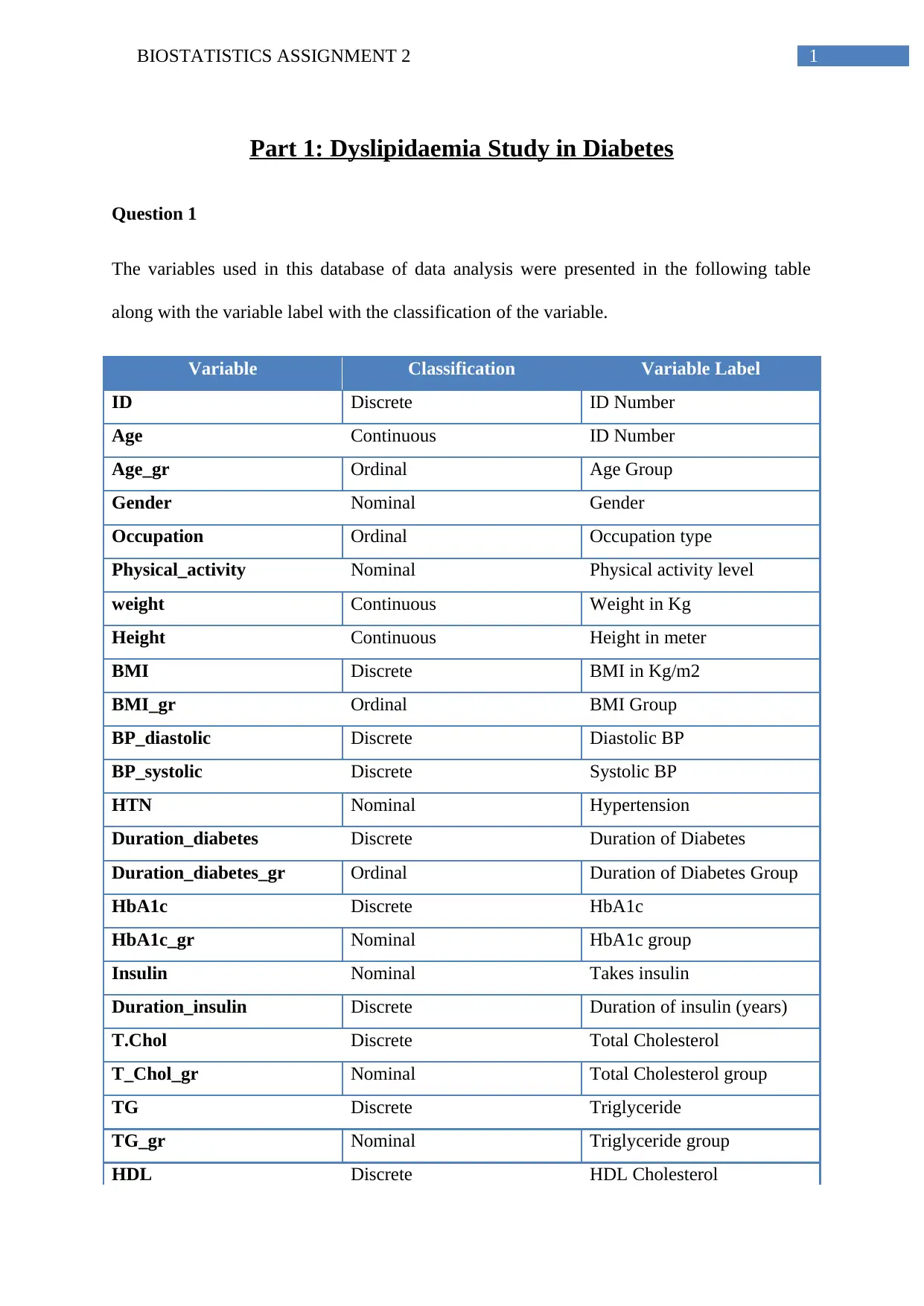
1BIOSTATISTICS ASSIGNMENT 2
Part 1: Dyslipidaemia Study in Diabetes
Question 1
The variables used in this database of data analysis were presented in the following table
along with the variable label with the classification of the variable.
Variable Classification Variable Label
ID Discrete ID Number
Age Continuous ID Number
Age_gr Ordinal Age Group
Gender Nominal Gender
Occupation Ordinal Occupation type
Physical_activity Nominal Physical activity level
weight Continuous Weight in Kg
Height Continuous Height in meter
BMI Discrete BMI in Kg/m2
BMI_gr Ordinal BMI Group
BP_diastolic Discrete Diastolic BP
BP_systolic Discrete Systolic BP
HTN Nominal Hypertension
Duration_diabetes Discrete Duration of Diabetes
Duration_diabetes_gr Ordinal Duration of Diabetes Group
HbA1c Discrete HbA1c
HbA1c_gr Nominal HbA1c group
Insulin Nominal Takes insulin
Duration_insulin Discrete Duration of insulin (years)
T.Chol Discrete Total Cholesterol
T_Chol_gr Nominal Total Cholesterol group
TG Discrete Triglyceride
TG_gr Nominal Triglyceride group
HDL Discrete HDL Cholesterol
Part 1: Dyslipidaemia Study in Diabetes
Question 1
The variables used in this database of data analysis were presented in the following table
along with the variable label with the classification of the variable.
Variable Classification Variable Label
ID Discrete ID Number
Age Continuous ID Number
Age_gr Ordinal Age Group
Gender Nominal Gender
Occupation Ordinal Occupation type
Physical_activity Nominal Physical activity level
weight Continuous Weight in Kg
Height Continuous Height in meter
BMI Discrete BMI in Kg/m2
BMI_gr Ordinal BMI Group
BP_diastolic Discrete Diastolic BP
BP_systolic Discrete Systolic BP
HTN Nominal Hypertension
Duration_diabetes Discrete Duration of Diabetes
Duration_diabetes_gr Ordinal Duration of Diabetes Group
HbA1c Discrete HbA1c
HbA1c_gr Nominal HbA1c group
Insulin Nominal Takes insulin
Duration_insulin Discrete Duration of insulin (years)
T.Chol Discrete Total Cholesterol
T_Chol_gr Nominal Total Cholesterol group
TG Discrete Triglyceride
TG_gr Nominal Triglyceride group
HDL Discrete HDL Cholesterol
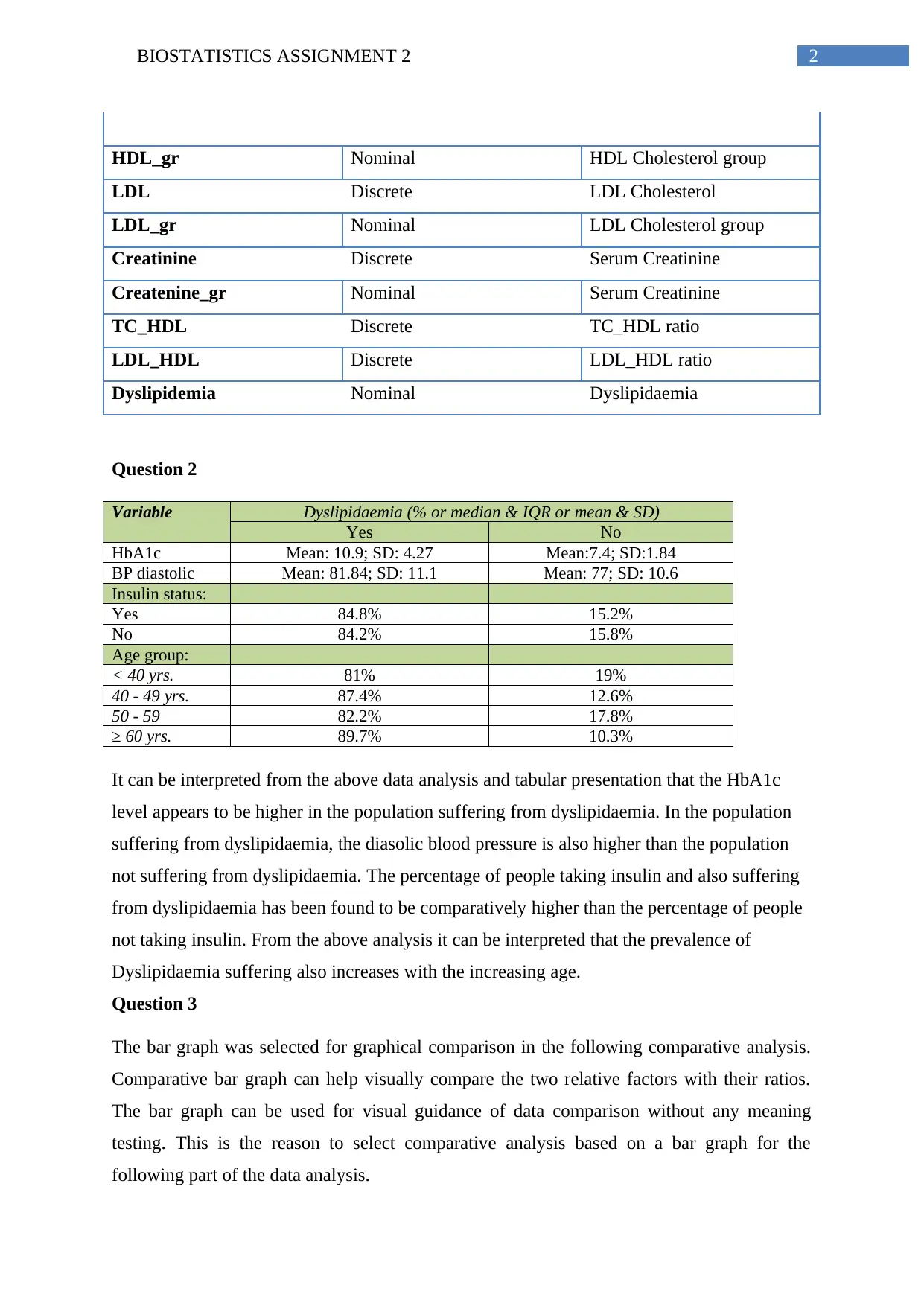
2BIOSTATISTICS ASSIGNMENT 2
HDL_gr Nominal HDL Cholesterol group
LDL Discrete LDL Cholesterol
LDL_gr Nominal LDL Cholesterol group
Creatinine Discrete Serum Creatinine
Createnine_gr Nominal Serum Creatinine
TC_HDL Discrete TC_HDL ratio
LDL_HDL Discrete LDL_HDL ratio
Dyslipidemia Nominal Dyslipidaemia
Question 2
Variable Dyslipidaemia (% or median & IQR or mean & SD)
Yes No
HbA1c Mean: 10.9; SD: 4.27 Mean:7.4; SD:1.84
BP diastolic Mean: 81.84; SD: 11.1 Mean: 77; SD: 10.6
Insulin status:
Yes 84.8% 15.2%
No 84.2% 15.8%
Age group:
< 40 yrs. 81% 19%
40 - 49 yrs. 87.4% 12.6%
50 - 59 82.2% 17.8%
≥ 60 yrs. 89.7% 10.3%
It can be interpreted from the above data analysis and tabular presentation that the HbA1c
level appears to be higher in the population suffering from dyslipidaemia. In the population
suffering from dyslipidaemia, the diasolic blood pressure is also higher than the population
not suffering from dyslipidaemia. The percentage of people taking insulin and also suffering
from dyslipidaemia has been found to be comparatively higher than the percentage of people
not taking insulin. From the above analysis it can be interpreted that the prevalence of
Dyslipidaemia suffering also increases with the increasing age.
Question 3
The bar graph was selected for graphical comparison in the following comparative analysis.
Comparative bar graph can help visually compare the two relative factors with their ratios.
The bar graph can be used for visual guidance of data comparison without any meaning
testing. This is the reason to select comparative analysis based on a bar graph for the
following part of the data analysis.
HDL_gr Nominal HDL Cholesterol group
LDL Discrete LDL Cholesterol
LDL_gr Nominal LDL Cholesterol group
Creatinine Discrete Serum Creatinine
Createnine_gr Nominal Serum Creatinine
TC_HDL Discrete TC_HDL ratio
LDL_HDL Discrete LDL_HDL ratio
Dyslipidemia Nominal Dyslipidaemia
Question 2
Variable Dyslipidaemia (% or median & IQR or mean & SD)
Yes No
HbA1c Mean: 10.9; SD: 4.27 Mean:7.4; SD:1.84
BP diastolic Mean: 81.84; SD: 11.1 Mean: 77; SD: 10.6
Insulin status:
Yes 84.8% 15.2%
No 84.2% 15.8%
Age group:
< 40 yrs. 81% 19%
40 - 49 yrs. 87.4% 12.6%
50 - 59 82.2% 17.8%
≥ 60 yrs. 89.7% 10.3%
It can be interpreted from the above data analysis and tabular presentation that the HbA1c
level appears to be higher in the population suffering from dyslipidaemia. In the population
suffering from dyslipidaemia, the diasolic blood pressure is also higher than the population
not suffering from dyslipidaemia. The percentage of people taking insulin and also suffering
from dyslipidaemia has been found to be comparatively higher than the percentage of people
not taking insulin. From the above analysis it can be interpreted that the prevalence of
Dyslipidaemia suffering also increases with the increasing age.
Question 3
The bar graph was selected for graphical comparison in the following comparative analysis.
Comparative bar graph can help visually compare the two relative factors with their ratios.
The bar graph can be used for visual guidance of data comparison without any meaning
testing. This is the reason to select comparative analysis based on a bar graph for the
following part of the data analysis.
You're viewing a preview
Unlock full access by subscribing today!
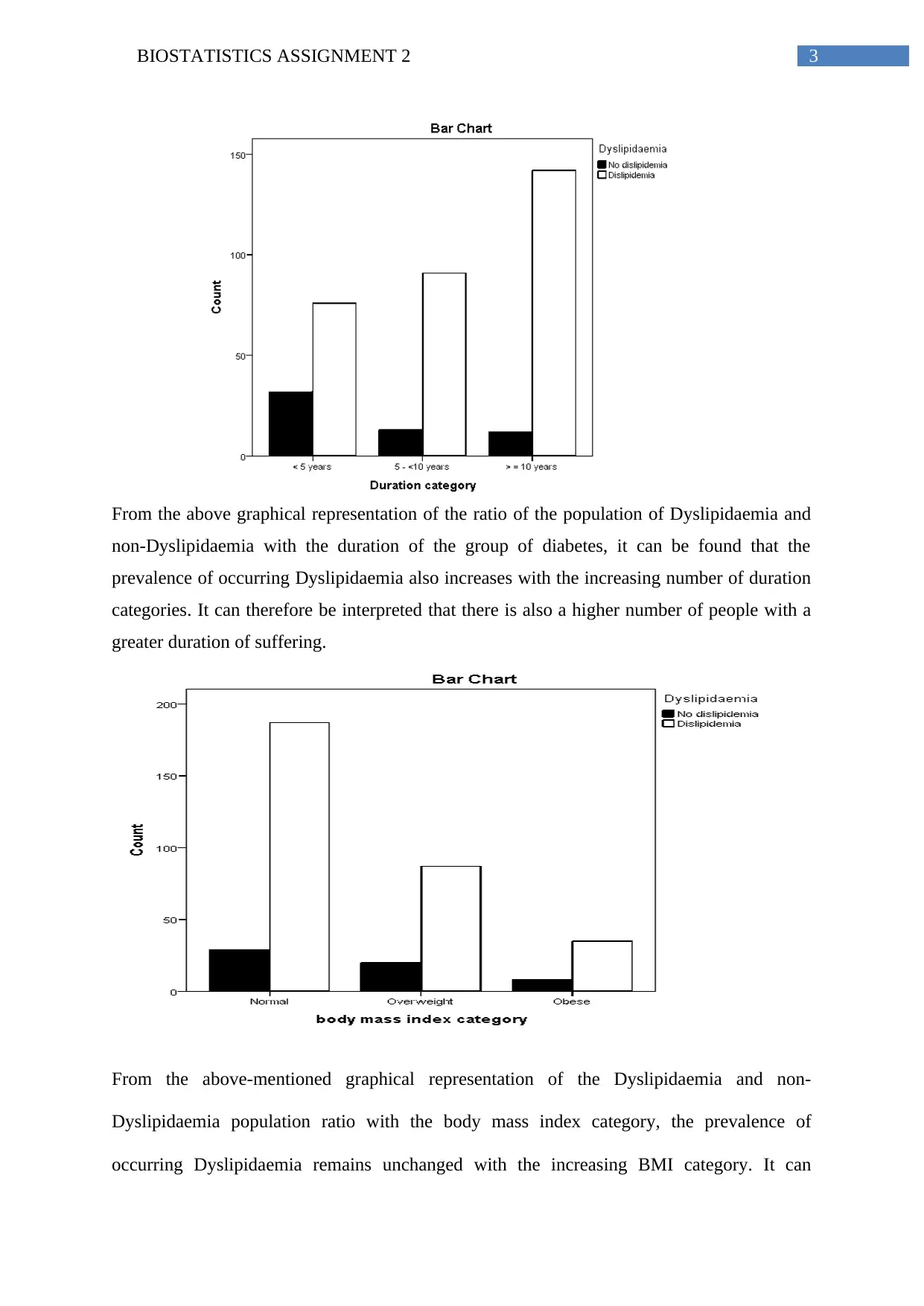
3BIOSTATISTICS ASSIGNMENT 2
From the above graphical representation of the ratio of the population of Dyslipidaemia and
non-Dyslipidaemia with the duration of the group of diabetes, it can be found that the
prevalence of occurring Dyslipidaemia also increases with the increasing number of duration
categories. It can therefore be interpreted that there is also a higher number of people with a
greater duration of suffering.
From the above-mentioned graphical representation of the Dyslipidaemia and non-
Dyslipidaemia population ratio with the body mass index category, the prevalence of
occurring Dyslipidaemia remains unchanged with the increasing BMI category. It can
From the above graphical representation of the ratio of the population of Dyslipidaemia and
non-Dyslipidaemia with the duration of the group of diabetes, it can be found that the
prevalence of occurring Dyslipidaemia also increases with the increasing number of duration
categories. It can therefore be interpreted that there is also a higher number of people with a
greater duration of suffering.
From the above-mentioned graphical representation of the Dyslipidaemia and non-
Dyslipidaemia population ratio with the body mass index category, the prevalence of
occurring Dyslipidaemia remains unchanged with the increasing BMI category. It can
Paraphrase This Document
Need a fresh take? Get an instant paraphrase of this document with our AI Paraphraser
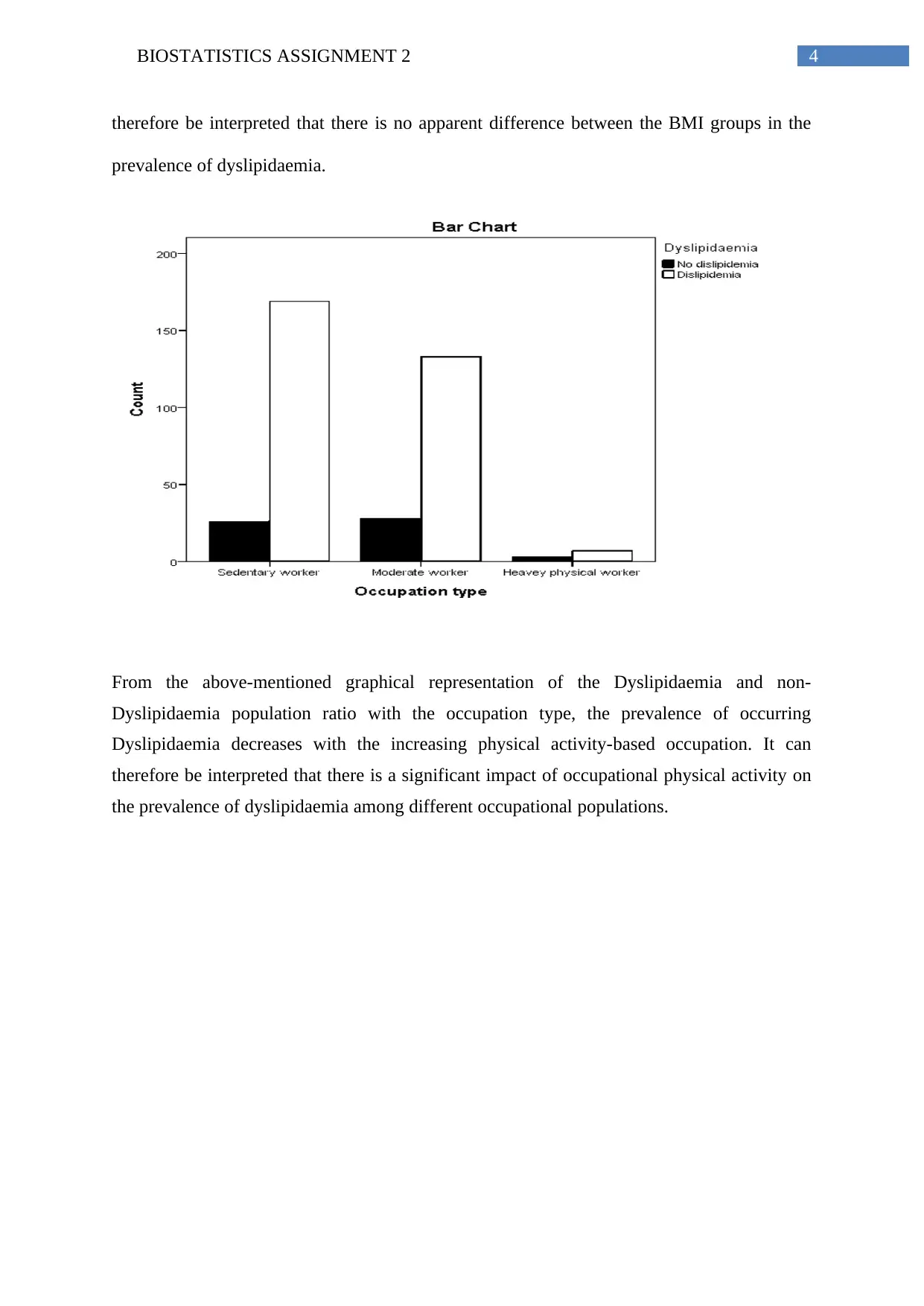
4BIOSTATISTICS ASSIGNMENT 2
therefore be interpreted that there is no apparent difference between the BMI groups in the
prevalence of dyslipidaemia.
From the above-mentioned graphical representation of the Dyslipidaemia and non-
Dyslipidaemia population ratio with the occupation type, the prevalence of occurring
Dyslipidaemia decreases with the increasing physical activity-based occupation. It can
therefore be interpreted that there is a significant impact of occupational physical activity on
the prevalence of dyslipidaemia among different occupational populations.
therefore be interpreted that there is no apparent difference between the BMI groups in the
prevalence of dyslipidaemia.
From the above-mentioned graphical representation of the Dyslipidaemia and non-
Dyslipidaemia population ratio with the occupation type, the prevalence of occurring
Dyslipidaemia decreases with the increasing physical activity-based occupation. It can
therefore be interpreted that there is a significant impact of occupational physical activity on
the prevalence of dyslipidaemia among different occupational populations.
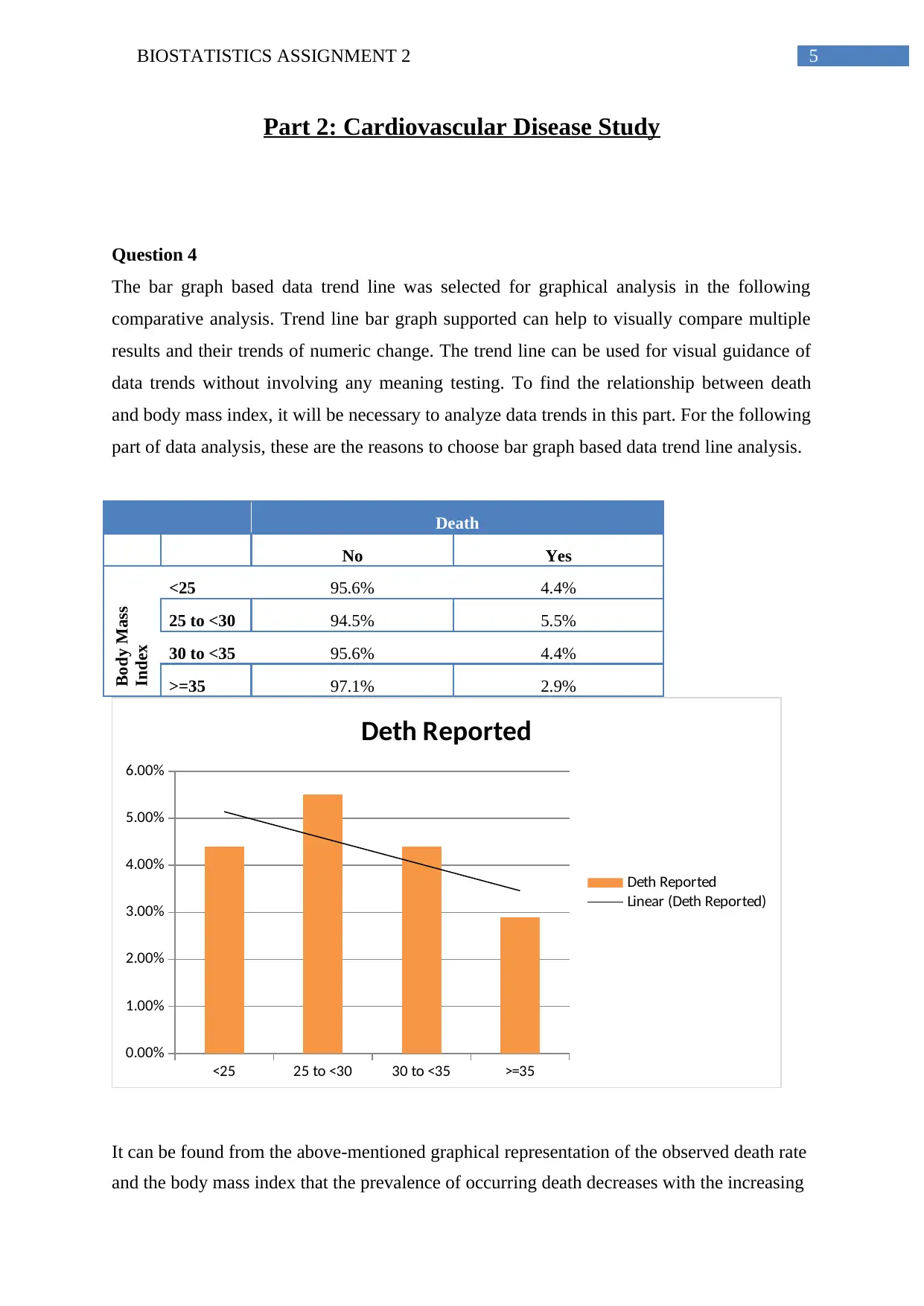
5BIOSTATISTICS ASSIGNMENT 2
Part 2: Cardiovascular Disease Study
Question 4
The bar graph based data trend line was selected for graphical analysis in the following
comparative analysis. Trend line bar graph supported can help to visually compare multiple
results and their trends of numeric change. The trend line can be used for visual guidance of
data trends without involving any meaning testing. To find the relationship between death
and body mass index, it will be necessary to analyze data trends in this part. For the following
part of data analysis, these are the reasons to choose bar graph based data trend line analysis.
Death
No Yes
Body Mass
Index
<25 95.6% 4.4%
25 to <30 94.5% 5.5%
30 to <35 95.6% 4.4%
>=35 97.1% 2.9%
<25 25 to <30 30 to <35 >=35
0.00%
1.00%
2.00%
3.00%
4.00%
5.00%
6.00%
Deth Reported
Deth Reported
Linear (Deth Reported)
It can be found from the above-mentioned graphical representation of the observed death rate
and the body mass index that the prevalence of occurring death decreases with the increasing
Part 2: Cardiovascular Disease Study
Question 4
The bar graph based data trend line was selected for graphical analysis in the following
comparative analysis. Trend line bar graph supported can help to visually compare multiple
results and their trends of numeric change. The trend line can be used for visual guidance of
data trends without involving any meaning testing. To find the relationship between death
and body mass index, it will be necessary to analyze data trends in this part. For the following
part of data analysis, these are the reasons to choose bar graph based data trend line analysis.
Death
No Yes
Body Mass
Index
<25 95.6% 4.4%
25 to <30 94.5% 5.5%
30 to <35 95.6% 4.4%
>=35 97.1% 2.9%
<25 25 to <30 30 to <35 >=35
0.00%
1.00%
2.00%
3.00%
4.00%
5.00%
6.00%
Deth Reported
Deth Reported
Linear (Deth Reported)
It can be found from the above-mentioned graphical representation of the observed death rate
and the body mass index that the prevalence of occurring death decreases with the increasing
You're viewing a preview
Unlock full access by subscribing today!
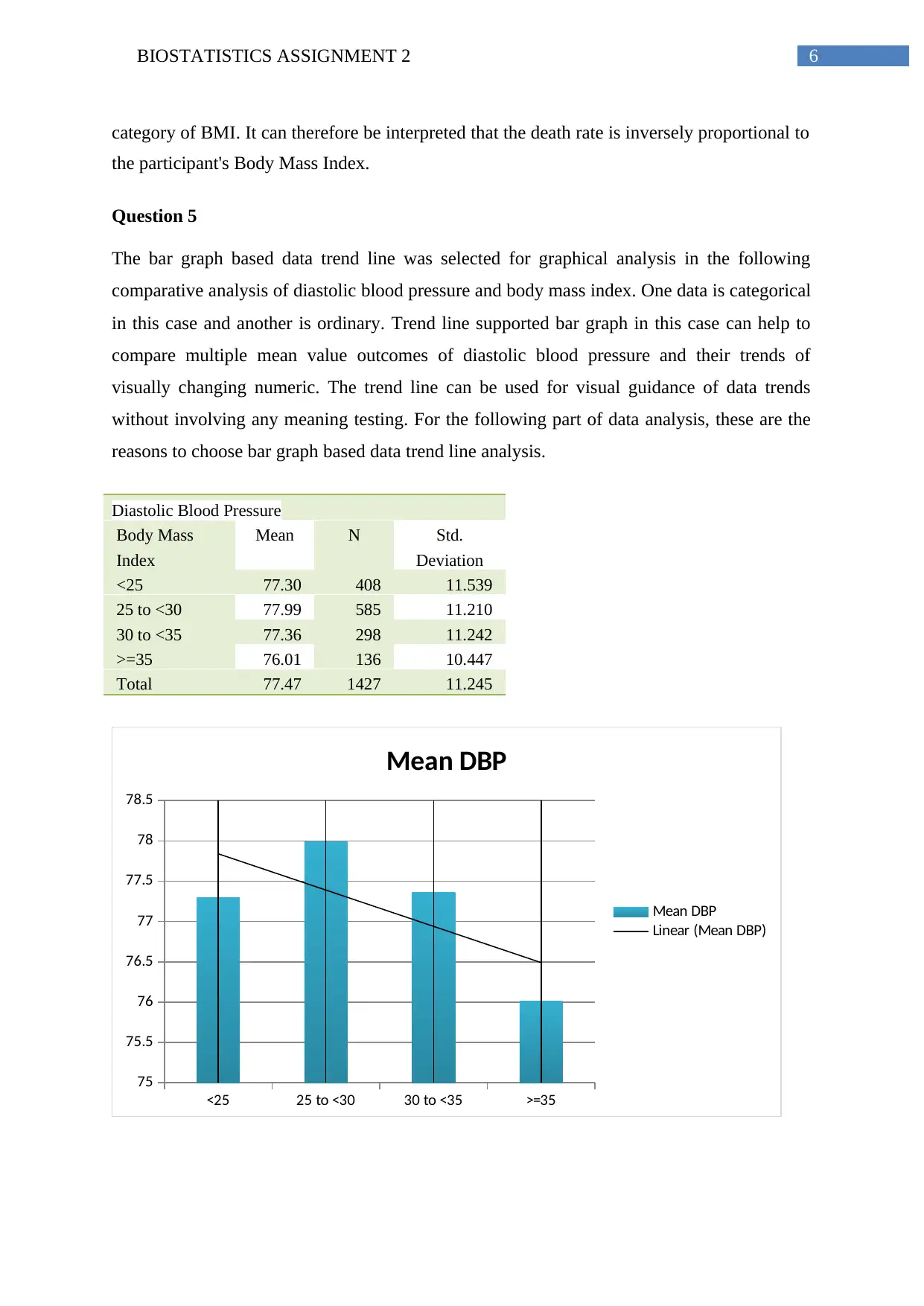
6BIOSTATISTICS ASSIGNMENT 2
category of BMI. It can therefore be interpreted that the death rate is inversely proportional to
the participant's Body Mass Index.
Question 5
The bar graph based data trend line was selected for graphical analysis in the following
comparative analysis of diastolic blood pressure and body mass index. One data is categorical
in this case and another is ordinary. Trend line supported bar graph in this case can help to
compare multiple mean value outcomes of diastolic blood pressure and their trends of
visually changing numeric. The trend line can be used for visual guidance of data trends
without involving any meaning testing. For the following part of data analysis, these are the
reasons to choose bar graph based data trend line analysis.
Diastolic Blood Pressure
Body Mass
Index
Mean N Std.
Deviation
<25 77.30 408 11.539
25 to <30 77.99 585 11.210
30 to <35 77.36 298 11.242
>=35 76.01 136 10.447
Total 77.47 1427 11.245
<25 25 to <30 30 to <35 >=35
75
75.5
76
76.5
77
77.5
78
78.5
Mean DBP
Mean DBP
Linear (Mean DBP)
category of BMI. It can therefore be interpreted that the death rate is inversely proportional to
the participant's Body Mass Index.
Question 5
The bar graph based data trend line was selected for graphical analysis in the following
comparative analysis of diastolic blood pressure and body mass index. One data is categorical
in this case and another is ordinary. Trend line supported bar graph in this case can help to
compare multiple mean value outcomes of diastolic blood pressure and their trends of
visually changing numeric. The trend line can be used for visual guidance of data trends
without involving any meaning testing. For the following part of data analysis, these are the
reasons to choose bar graph based data trend line analysis.
Diastolic Blood Pressure
Body Mass
Index
Mean N Std.
Deviation
<25 77.30 408 11.539
25 to <30 77.99 585 11.210
30 to <35 77.36 298 11.242
>=35 76.01 136 10.447
Total 77.47 1427 11.245
<25 25 to <30 30 to <35 >=35
75
75.5
76
76.5
77
77.5
78
78.5
Mean DBP
Mean DBP
Linear (Mean DBP)
Paraphrase This Document
Need a fresh take? Get an instant paraphrase of this document with our AI Paraphraser
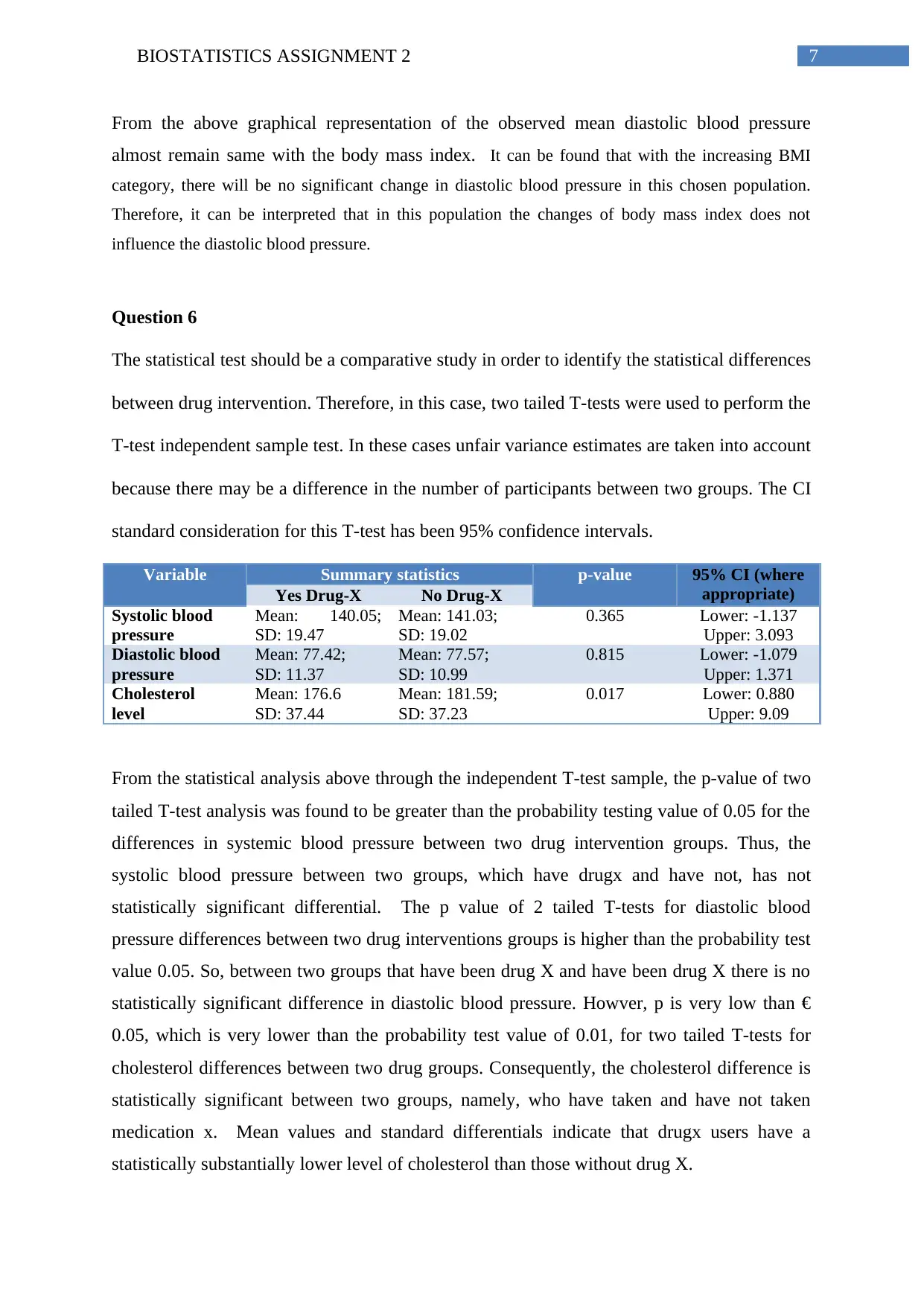
7BIOSTATISTICS ASSIGNMENT 2
From the above graphical representation of the observed mean diastolic blood pressure
almost remain same with the body mass index. It can be found that with the increasing BMI
category, there will be no significant change in diastolic blood pressure in this chosen population.
Therefore, it can be interpreted that in this population the changes of body mass index does not
influence the diastolic blood pressure.
Question 6
The statistical test should be a comparative study in order to identify the statistical differences
between drug intervention. Therefore, in this case, two tailed T-tests were used to perform the
T-test independent sample test. In these cases unfair variance estimates are taken into account
because there may be a difference in the number of participants between two groups. The CI
standard consideration for this T-test has been 95% confidence intervals.
Variable Summary statistics p-value 95% CI (where
appropriate)Yes Drug-X No Drug-X
Systolic blood
pressure
Mean: 140.05;
SD: 19.47
Mean: 141.03;
SD: 19.02
0.365 Lower: -1.137
Upper: 3.093
Diastolic blood
pressure
Mean: 77.42;
SD: 11.37
Mean: 77.57;
SD: 10.99
0.815 Lower: -1.079
Upper: 1.371
Cholesterol
level
Mean: 176.6
SD: 37.44
Mean: 181.59;
SD: 37.23
0.017 Lower: 0.880
Upper: 9.09
From the statistical analysis above through the independent T-test sample, the p-value of two
tailed T-test analysis was found to be greater than the probability testing value of 0.05 for the
differences in systemic blood pressure between two drug intervention groups. Thus, the
systolic blood pressure between two groups, which have drugx and have not, has not
statistically significant differential. The p value of 2 tailed T-tests for diastolic blood
pressure differences between two drug interventions groups is higher than the probability test
value 0.05. So, between two groups that have been drug X and have been drug X there is no
statistically significant difference in diastolic blood pressure. Howver, p is very low than €
0.05, which is very lower than the probability test value of 0.01, for two tailed T-tests for
cholesterol differences between two drug groups. Consequently, the cholesterol difference is
statistically significant between two groups, namely, who have taken and have not taken
medication x. Mean values and standard differentials indicate that drugx users have a
statistically substantially lower level of cholesterol than those without drug X.
From the above graphical representation of the observed mean diastolic blood pressure
almost remain same with the body mass index. It can be found that with the increasing BMI
category, there will be no significant change in diastolic blood pressure in this chosen population.
Therefore, it can be interpreted that in this population the changes of body mass index does not
influence the diastolic blood pressure.
Question 6
The statistical test should be a comparative study in order to identify the statistical differences
between drug intervention. Therefore, in this case, two tailed T-tests were used to perform the
T-test independent sample test. In these cases unfair variance estimates are taken into account
because there may be a difference in the number of participants between two groups. The CI
standard consideration for this T-test has been 95% confidence intervals.
Variable Summary statistics p-value 95% CI (where
appropriate)Yes Drug-X No Drug-X
Systolic blood
pressure
Mean: 140.05;
SD: 19.47
Mean: 141.03;
SD: 19.02
0.365 Lower: -1.137
Upper: 3.093
Diastolic blood
pressure
Mean: 77.42;
SD: 11.37
Mean: 77.57;
SD: 10.99
0.815 Lower: -1.079
Upper: 1.371
Cholesterol
level
Mean: 176.6
SD: 37.44
Mean: 181.59;
SD: 37.23
0.017 Lower: 0.880
Upper: 9.09
From the statistical analysis above through the independent T-test sample, the p-value of two
tailed T-test analysis was found to be greater than the probability testing value of 0.05 for the
differences in systemic blood pressure between two drug intervention groups. Thus, the
systolic blood pressure between two groups, which have drugx and have not, has not
statistically significant differential. The p value of 2 tailed T-tests for diastolic blood
pressure differences between two drug interventions groups is higher than the probability test
value 0.05. So, between two groups that have been drug X and have been drug X there is no
statistically significant difference in diastolic blood pressure. Howver, p is very low than €
0.05, which is very lower than the probability test value of 0.01, for two tailed T-tests for
cholesterol differences between two drug groups. Consequently, the cholesterol difference is
statistically significant between two groups, namely, who have taken and have not taken
medication x. Mean values and standard differentials indicate that drugx users have a
statistically substantially lower level of cholesterol than those without drug X.
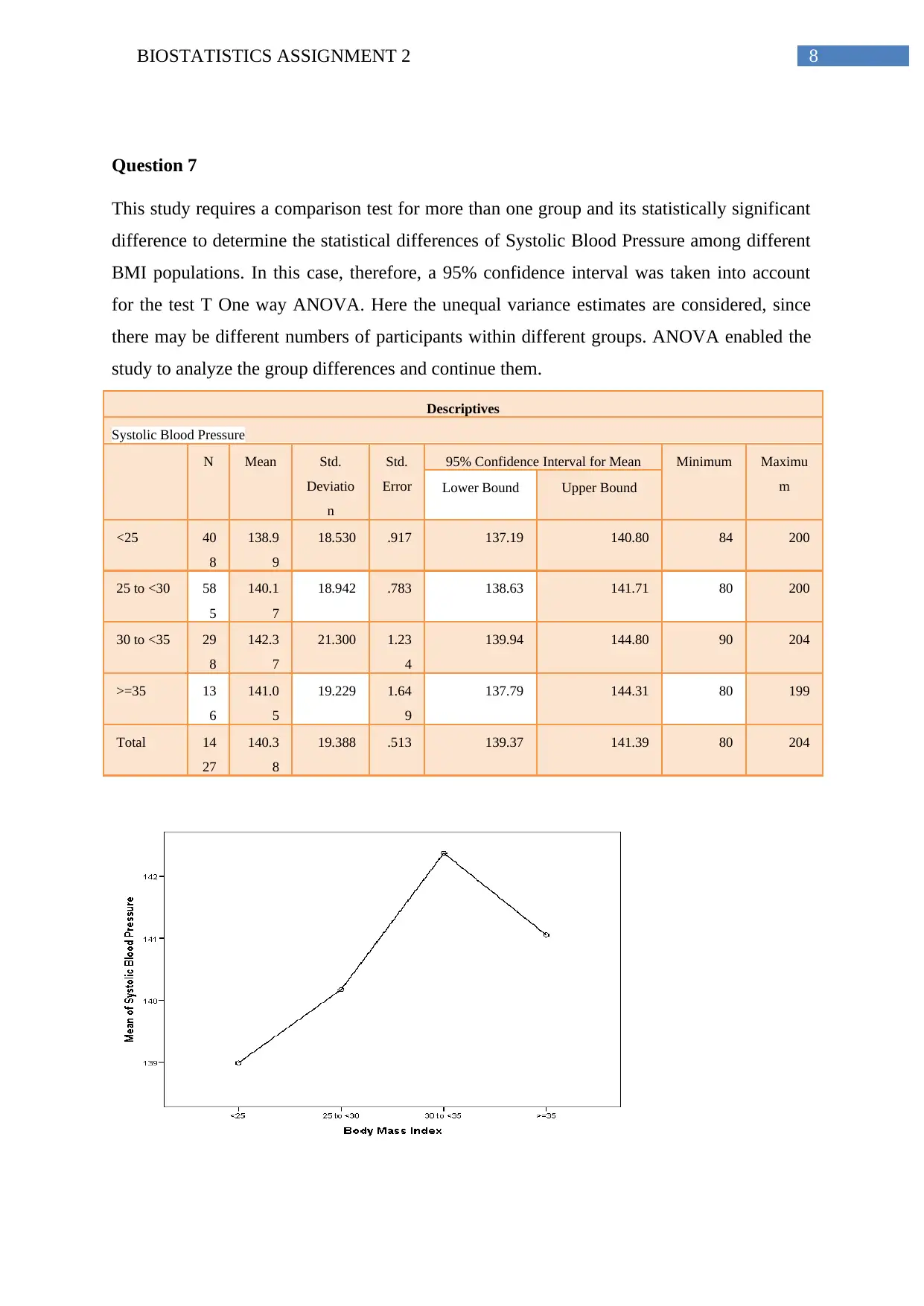
8BIOSTATISTICS ASSIGNMENT 2
Question 7
This study requires a comparison test for more than one group and its statistically significant
difference to determine the statistical differences of Systolic Blood Pressure among different
BMI populations. In this case, therefore, a 95% confidence interval was taken into account
for the test T One way ANOVA. Here the unequal variance estimates are considered, since
there may be different numbers of participants within different groups. ANOVA enabled the
study to analyze the group differences and continue them.
Descriptives
Systolic Blood Pressure
N Mean Std.
Deviatio
n
Std.
Error
95% Confidence Interval for Mean Minimum Maximu
mLower Bound Upper Bound
<25 40
8
138.9
9
18.530 .917 137.19 140.80 84 200
25 to <30 58
5
140.1
7
18.942 .783 138.63 141.71 80 200
30 to <35 29
8
142.3
7
21.300 1.23
4
139.94 144.80 90 204
>=35 13
6
141.0
5
19.229 1.64
9
137.79 144.31 80 199
Total 14
27
140.3
8
19.388 .513 139.37 141.39 80 204
Question 7
This study requires a comparison test for more than one group and its statistically significant
difference to determine the statistical differences of Systolic Blood Pressure among different
BMI populations. In this case, therefore, a 95% confidence interval was taken into account
for the test T One way ANOVA. Here the unequal variance estimates are considered, since
there may be different numbers of participants within different groups. ANOVA enabled the
study to analyze the group differences and continue them.
Descriptives
Systolic Blood Pressure
N Mean Std.
Deviatio
n
Std.
Error
95% Confidence Interval for Mean Minimum Maximu
mLower Bound Upper Bound
<25 40
8
138.9
9
18.530 .917 137.19 140.80 84 200
25 to <30 58
5
140.1
7
18.942 .783 138.63 141.71 80 200
30 to <35 29
8
142.3
7
21.300 1.23
4
139.94 144.80 90 204
>=35 13
6
141.0
5
19.229 1.64
9
137.79 144.31 80 199
Total 14
27
140.3
8
19.388 .513 139.37 141.39 80 204
You're viewing a preview
Unlock full access by subscribing today!
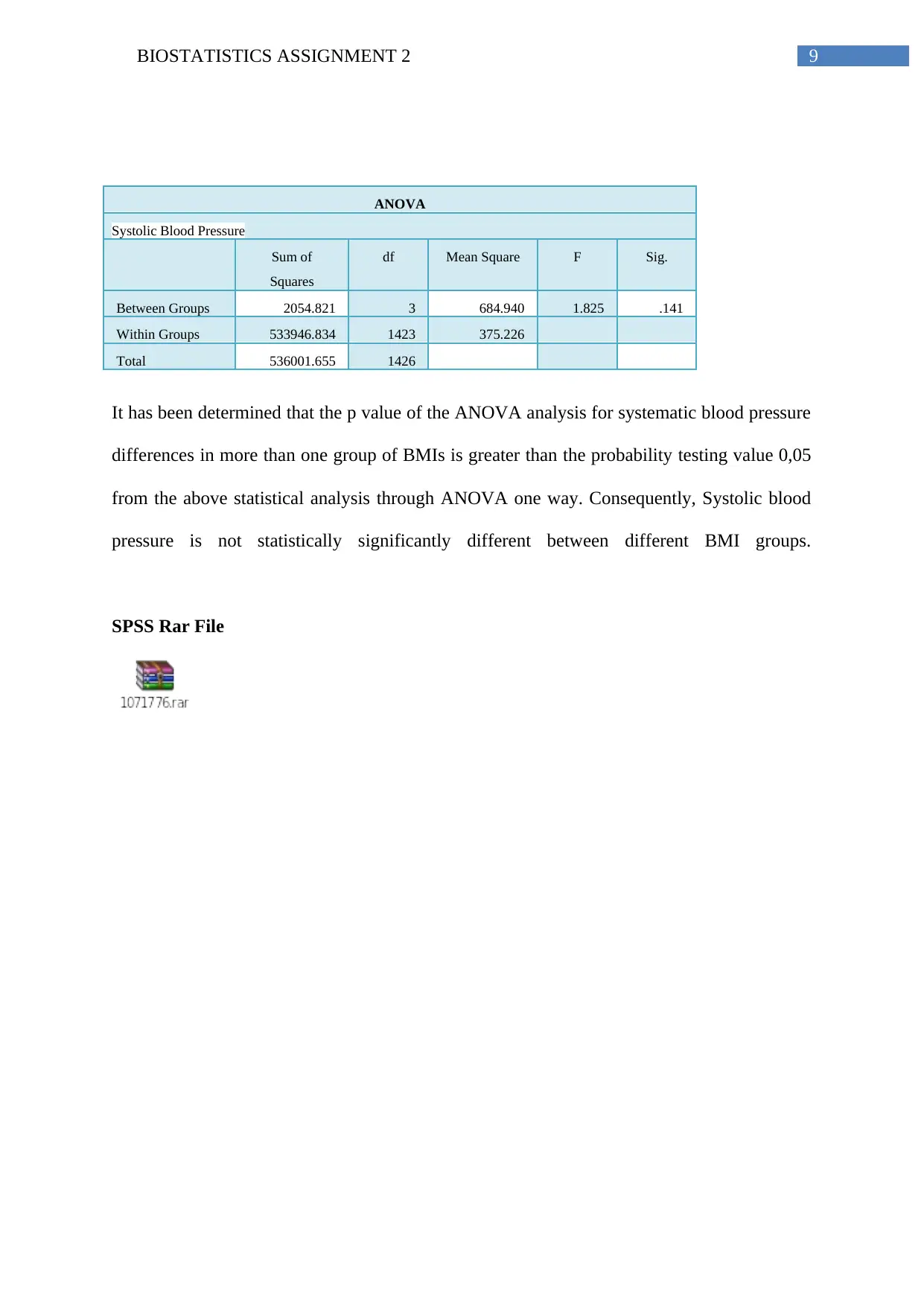
9BIOSTATISTICS ASSIGNMENT 2
ANOVA
Systolic Blood Pressure
Sum of
Squares
df Mean Square F Sig.
Between Groups 2054.821 3 684.940 1.825 .141
Within Groups 533946.834 1423 375.226
Total 536001.655 1426
It has been determined that the p value of the ANOVA analysis for systematic blood pressure
differences in more than one group of BMIs is greater than the probability testing value 0,05
from the above statistical analysis through ANOVA one way. Consequently, Systolic blood
pressure is not statistically significantly different between different BMI groups.
SPSS Rar File
ANOVA
Systolic Blood Pressure
Sum of
Squares
df Mean Square F Sig.
Between Groups 2054.821 3 684.940 1.825 .141
Within Groups 533946.834 1423 375.226
Total 536001.655 1426
It has been determined that the p value of the ANOVA analysis for systematic blood pressure
differences in more than one group of BMIs is greater than the probability testing value 0,05
from the above statistical analysis through ANOVA one way. Consequently, Systolic blood
pressure is not statistically significantly different between different BMI groups.
SPSS Rar File
1 out of 10
Your All-in-One AI-Powered Toolkit for Academic Success.
+13062052269
info@desklib.com
Available 24*7 on WhatsApp / Email
![[object Object]](/_next/static/media/star-bottom.7253800d.svg)
Unlock your academic potential
© 2024 | Zucol Services PVT LTD | All rights reserved.

